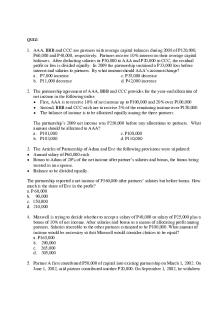Theories on Accounting PDF

| Title | Theories on Accounting |
|---|---|
| Course | Accountancy |
| Institution | Polytechnic University of the Philippines |
| Pages | 4 |
| File Size | 113.9 KB |
| File Type | |
| Total Downloads | 4 |
| Total Views | 153 |
Summary
Accounting Test Bank...
Description
THEORIES PART I – TRUE/FALSE
TRUE FALSE TRUE TRUE FALSE TRUE FALSE TRUE FALSE FALSE FALSE FALSE TRUE FALSE FALSE TRUE FALSE TRUE TRUE FALSE
1. Failure to record the adjusting entry for accrued salaries results in the current year’s profit being overstated. 2. As equipment is depreciated, its book value increases and its accumulated depreciation increases. 3. An adjusting entry includes at least one balance sheet account and at least one income statement account. 4. Failure to record the adjusting entry for depreciation will overstate assets on the balance sheet. 5. In recording the adjusting entry for accrued salaries, all accounts involved are decreased. 6. The expiration of usefulness of equipment during an accounting period is called depreciation. 7. Acquiring a computer for cash is just exchanging one asset for another and will not result in an expense even in future periods. 8. Applying accrual accounting results in a more accurate measurement of profit for the period than does the cash basis of accounting. 9. Adjusting entries affect cash flows in the current period. 10. Accrual accounting recognizes revenues and expenses at the point that cash changes hands. 11. A deferral is the recognition of an expense that has arisen but has not yet been recorded. 12. Assets become liabilities when they expire. 13. Recording incurred but unpaid expenses is an example of an accrual. 14. A company’s fiscal year must correspond to the calendar year. 15. If all transactions were originally recorded in conformity with GAAP, there would be no need for adjusting entries at the end of the period. 16. The adjusting entry to recognize earned commission revenues not previously recorded or billed will cause total assets to increase. 17. When the reduction in prepaid expenses is not properly recorded, this causes the asset accounts and expenses accounts to be understated. 18. Accumulated depreciation accounts may be referred to as contra-asset accounts. 19. Accounts that are partly income statement amount and partly balance sheet amounts are called mixed accounts. 20. An asset’s book value represents the true market value of the asset.
PART II – MULTIPLE CHOICE
1. Which of the following is not an application of accrual accounting? a. Adjusting the accounts b. Applying the cash basis of accounting c. Applying the matching rule d. Recognizing revenues when earned and expenses when incurred. 2. A service vehicle might be depreciated over 5 years because a. Income tax provisions require depreciation over the next 5 years. b. It will be paid for in 5 years. c. It will help generate revenue for the company over the next 5 years. d. It will lose most of its market value in 5 years. 3. The journal entry to record an accrued expense results in which of the following types of accounts being debited and credited? a. Asset and income b. Asset and liability c. Expense and asset d. Expense and liability 4. If a P2,500 adjustment for depreciation is omitted, which of the following financial statement errors will occur? a. Assets will be understated b. Expenses will be overstated c. Owner’s equity will be overstated d. Profit will be understated 5. The amount of accrued but unpaid expenses at the end of the period is both an expense and a. a deferral b. a liability c. an asset d. an income 6. Accrued revenues a. decrease assets b. decrease liabilities c. increase assets d. increase liabilities 7. Accrued expenses a. decrease assets b. decrease liabilities c. increase assets d. increase liabilities
8. The word “accrued” implies which of the following? a. Money has been paid and the service has been provided. b. Money has been paid but no services have been provided. c. Money has been paid for a service to be performed during the next period. d. Money has not been paid or received but the service has already been performed or rendered. 9. If an adjusting entry was not made at the end of a period to remove the earned revenue from the unearned revenues account, a. assets would be understated b. liabilities would be overstated c. liabilities would be understated d. owner’s equity would be overstated 10. Which of the following transactions results in an increase in revenue? a. collection of cash on account b. receipt of cash from bank loan c. sale of land at cost for cash d. services rendered on credit 11. An item that represents services received by the firm for which it will pay for in the future is called a. accrued expense b. accrued revenue c. unearned revenue d. prepaid expense 12. An item that represents services provided by a firm for which it will receive payment in the future is called a. prepaid expense b. accrued expense c. accrued revenue d. unearned revenue 13. Which of the following is an example of an adjusting entry? a. recording depreciation expense on a truck b. recording the billing of customers for service rendered c. recording the payment of salaries to employees d. recording the purchase of supplies on account 14. Which of the following pairs of accounts would not appear in the same adjusting entry? a. interest revenues and interest payable b. rent expense and rent payable c. service revenues and accounts payable d. service revenues and unearned revenues
15. A law firm began November with office supplies of P16,000. During the month, the firm purchased supplies of P29,000. On November 30, supplies on hand totaled P21,000. Supplies expense for the period is a. P24,000 b. P29,000 c. P45,000 d. P21,000 16. The adjusting entry to accrue salary expense a. debit salary expense and credit cash b. debit salary expense and credit salaries payable c. debit salaries payable and credit cash d. debit salaries payable and credit salary expense 17. Adjusting entries involve a. at least one real and one nominal account b. only capital accounts c. only nominal accounts d. only real accounts 18. A prepaid expense is not an a. asset b. economic resource c. expired cost d. unexpired cost 19. The decrease in usefulness of property and equipment as time passes is called a. consumption b. contra asset c. depreciation d. deterioration 20. Accumulated depreciation is reported in the a. balance sheet b. income statement c. statement of owner’s equity d. both a and b...
Similar Free PDFs
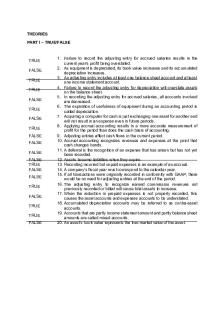
Theories on Accounting
- 4 Pages
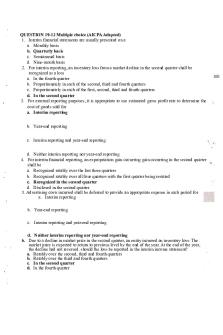
4 - Accounting Theories
- 4 Pages
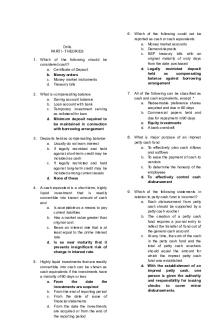
Accounting Theories with Answers
- 3 Pages
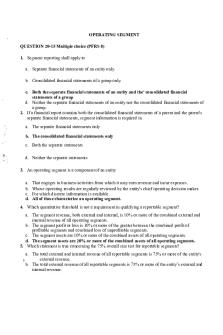
11 - Accounting Theories
- 11 Pages
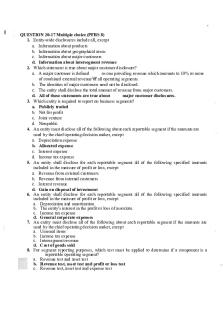
14 - Accounting Theories
- 3 Pages
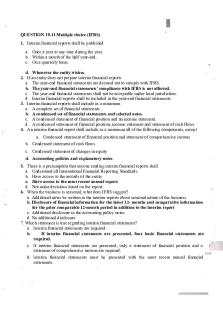
2 - Accounting Theories
- 4 Pages

Assignment ON Leadership theories
- 14 Pages

Durkheim Essay on Theories
- 9 Pages

Activity - On Theories of Good
- 2 Pages

Theories on Origin of State
- 21 Pages
Popular Institutions
- Tinajero National High School - Annex
- Politeknik Caltex Riau
- Yokohama City University
- SGT University
- University of Al-Qadisiyah
- Divine Word College of Vigan
- Techniek College Rotterdam
- Universidade de Santiago
- Universiti Teknologi MARA Cawangan Johor Kampus Pasir Gudang
- Poltekkes Kemenkes Yogyakarta
- Baguio City National High School
- Colegio san marcos
- preparatoria uno
- Centro de Bachillerato Tecnológico Industrial y de Servicios No. 107
- Dalian Maritime University
- Quang Trung Secondary School
- Colegio Tecnológico en Informática
- Corporación Regional de Educación Superior
- Grupo CEDVA
- Dar Al Uloom University
- Centro de Estudios Preuniversitarios de la Universidad Nacional de Ingeniería
- 上智大学
- Aakash International School, Nuna Majara
- San Felipe Neri Catholic School
- Kang Chiao International School - New Taipei City
- Misamis Occidental National High School
- Institución Educativa Escuela Normal Juan Ladrilleros
- Kolehiyo ng Pantukan
- Batanes State College
- Instituto Continental
- Sekolah Menengah Kejuruan Kesehatan Kaltara (Tarakan)
- Colegio de La Inmaculada Concepcion - Cebu


